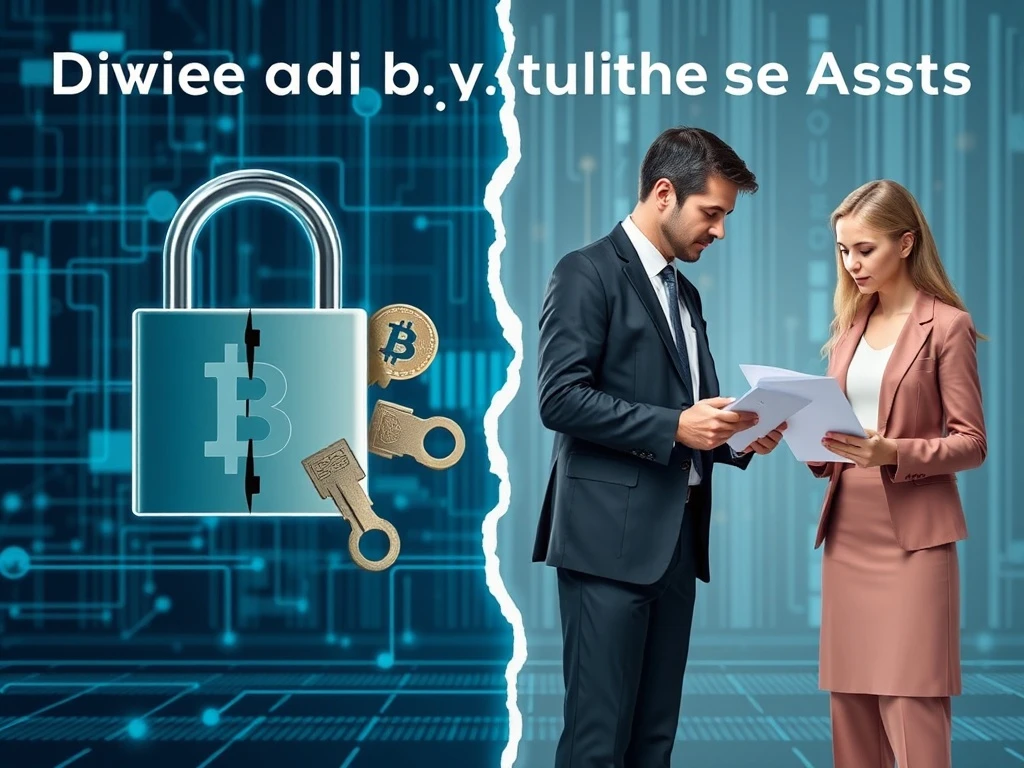Mastering Crypto Divorce: Securely Dividing Digital Assets with Private Keys and Multisig Wallets

Imagine navigating a divorce, where dividing your home or bank account is just one challenge. Now, add your Bitcoin wallet to the equation. Welcome to the modern world. Digital assets like cryptocurrency are increasingly part of marital property. The question, “Can you split a private key in half?” is no longer theoretical. It’s a very real concern for many. This article will break down what a private key is. We will explain why it cannot be split. Crucially, we will explore how crypto can still be divided in divorce. We will examine real case studies and introduce tools for fair, secure digital assets ownership.
The Indivisible Nature of a Crypto Private Key
A private key is essentially the password to your cryptocurrency. It is a long, unique string of letters and numbers. This key allows you to access your crypto wallet. You can then send or receive funds. If someone else possesses your private key, they can spend your crypto. If you lose it, your crypto is gone forever. Consider it like a bank PIN for digital money. Or, think of it as a house key. If someone has it, they can walk right in. No private key means no access, and therefore, no crypto.
Can you split a private key in half? The short answer is no, not directly. Suppose you are going through a crypto divorce. You and your spouse co-own a wallet with significant Bitcoin (BTC). Can you each take half of the private key as part of the asset split? This is not a safe approach. A private key is a single, indivisible string of data. It is like trying to cut a password in half. You cannot expect each half to still work. The private key must remain fully intact to access the wallet. Dividing it improperly risks permanently locking yourself out of your funds.
Here’s what happens if you try:
- Example (hypothetical): Private key:
5Kb8kLf9zgWQnogidDA76MzPL6TsZZY36hWXMssSzNydYXYB9KF - Split attempt:
- Half A:
5Kb8kLf9zgWQnogidDA7 - Half B:
6MzPL6TsZZY36hWXMssSzNydYXYB9KF
- Half A:
Neither of these parts can unlock the wallet alone. Worse, if either part is lost or altered, the entire key becomes unrecoverable. Tip: Never try to “split” a private key manually.
Crypto Assets in Divorce: A New Frontier for Marital Property
As cryptocurrency becomes more mainstream, it increasingly features in legal proceedings. Courts in many countries, including South Korea and the United States, now treat crypto like any other divisible asset in divorce cases. This means your digital assets are subject to the same division rules as real estate or traditional bank accounts. Hiding crypto can lead to severe legal penalties. Transparency is paramount.
Did you know? In South Korea, married couples can divide cryptocurrency holdings during divorce. Crypto is legally recognized as an intangible asset there. Courts can even order investigations to trace hidden digital assets using blockchain records. This highlights a growing global trend. Legal systems are adapting to the unique nature of digital wealth. Forensic accountants often assist in uncovering these assets.
Navigating Crypto Divorce: Legal and Technical Strategies
Fortunately, while the private key itself cannot be split, secure methods allow shared access and control of funds. These tools are invaluable during a crypto divorce. They provide fair and secure ownership solutions. Let’s explore three legally useful ways to manage joint crypto ownership:
- Shamir’s Secret Sharing (SSS)
- Multisignature Wallets (Multisig)
- Custodial Services or Legal Escrow Agreements
Securely Sharing Control: Shamir’s Secret Sharing Explained
Shamir’s Secret Sharing (SSS) is a cryptographic method. It allows you to divide a private key into several “shares.” This method is used when you want to break the key into multiple parts. Only a specific number of those parts are needed to rebuild it. You can specify how many shares are required to reconstruct the original key. For example, you might split a private key into three parts. You could then require any two of the three to unlock it.
Consider this example for dividing digital assets:
- Spouse A holds Share 1
- Spouse B holds Share 2
- A lawyer or trustee holds Share 3
If any two people agree, the key can be recovered and used. This system offers several advantages:
- Redundancy: Lose one share? The other two are enough.
- Security: No one person can act alone.
- Flexibility: This is good for divorces, estates, and business deals.
Shamir’s Secret Sharing is ideal when control should be shared. It prevents easy abuse. This method ensures that critical decisions require consensus. It adds a layer of protection against single points of failure or malicious actors. This makes it a powerful tool for managing valuable digital assets.
The Power of Multisig Wallets for Joint Crypto Ownership
Multisignature wallets, or multisig wallets, require multiple keys to move any crypto. Think of a multisig wallet as a digital safe. It demands more than one private key to authorize a transaction. This is much like a joint safe deposit box at a bank. Two or more keys are needed to open it. This technology provides a robust solution for shared ownership. It is especially useful in situations like a crypto divorce.
How a Multisig Wallet Works
When you create a multisig wallet, you define specific parameters. Tools like Electrum, Casa, or Gnosis Safe facilitate this process. You determine:
- The total number of keys that will exist.
- How many of those keys are necessary to approve a transaction.
This setup is often called an M-of-N configuration (e.g., two-of-three, three-of-five). In a two-of-three setup, for instance:
- Three separate private keys are generated.
- Each key is stored on its own device or controlled by a separate person.
Example: Key 1 goes to Spouse A. Key 2 goes to Spouse B. Key 3 goes to a neutral third party, like a divorce attorney, mediator, or escrow agent. The wallet requires two out of three signatures to approve a transaction. To move funds, both spouses must agree. Alternatively, one spouse and the neutral third party can approve a transaction. This works if the other party is unavailable or uncooperative. This setup is highly beneficial in divorce because it:
- Prevents either party from moving money unilaterally.
- Encourages cooperation and joint decision-making.
- Adds an extra layer of security against theft or disputes.
Multisig wallets are widely used in business. They are increasingly common in personal situations. These include divorce, inheritance planning, and family trusts. They offer unparalleled security and shared control for digital assets.
Custodial Services and Legal Escrow for Digital Asset Division
In some situations, especially when emotions run high or trust is low, a third party can manage crypto assets. This third party, a custodian, holds the private key. They manage transactions based on a legal agreement. This approach is particularly useful for digital asset division during contentious divorces. For example, Spouse A might want to keep the crypto. Spouse B agrees to receive an equal cash value. A law firm or crypto custodian then holds the private key. They keep it until the agreement is finalized. This ensures several key outcomes:
- Funds are not moved prematurely or without consent.
- Legal fairness is strictly enforced according to the agreement.
- The entire process follows agreed-upon terms, providing peace of mind.
Custodial services are common in estate planning. They are also used in divorce proceedings involving high-value or sensitive assets. They offer a neutral and secure way to manage complex asset divisions.
Tracing Hidden Crypto Assets: Forensic Tools in Action
Despite their reputation for anonymity, digital wallets and cryptocurrency transactions can be traced. This is especially true with the help of forensic accountants and blockchain analysis tools. As cryptocurrency becomes more common, it is increasingly treated as a marital asset. It is subject to the same division rules as other forms of property. Divorcing couples and their attorneys should understand these points:
- It’s property, not cash: Courts treat crypto like stocks or artwork. It is not like a checking account.
- It must be disclosed: Hiding crypto can result in serious legal penalties.
- It must be valued: Crypto is volatile. Parties often agree on a date or average value to determine its worth.
- It can be divided or offset: One spouse might keep the crypto. The other receives a proportional share of other assets (real estate, savings, etc.).
Accurate documentation, valuation, and transparency are essential. These ensure a fair and legal division of digital assets in divorce. A New York woman uncovered her husband’s secret Bitcoin stash worth $500,000 (12 BTC) during their separation. This case highlights the increasing prevalence of digital assets in divorce. It also shows the importance of forensic investigations.
Beyond Divorce: Crypto Ownership in Inheritance and Partnerships
The need to split or share crypto access extends well beyond divorce. These tools are also useful for other critical life events:
- Estate planning: Use Shamir’s Secret Sharing or multisig wallets. This ensures crypto passes securely to your heirs. It mitigates risks of loss or hacking.
- Family trusts: Grant children or family members limited access today. Full control can transfer at a future date or milestone.
- Business partnerships: Multisig wallets ensure no single person can withdraw company funds. This requires agreement from co-founders or board members.
Crypto ownership is a human matter. Even though crypto is digital, managing, sharing, and dividing it roots in human relationships and trust. You cannot literally split a private key in half. However, with the right tools, you can split access, share control, and divide value fairly. As cryptocurrency evolves from niche tech into a mainstream asset, knowing how to responsibly manage and divide it is crucial. This is especially true during life events like divorce, inheritance, or business dissolution. It is not just smart; it’s essential. This article does not contain investment advice or recommendations. Every investment and trading move involves risk, and readers should conduct their own research when making a decision.







